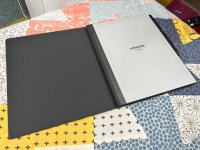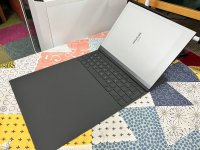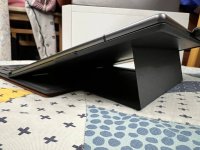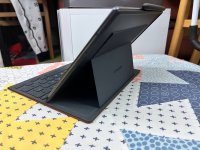 reMarkable 2 Type Folio (Hardware)
reMarkable 2 Type Folio (Hardware)
Official GBAtemp Review
Product Information:
- Official Store: https://remarkable.com/store/remarkable-2/type-folio
Review Approach:
It’s no secret that I love the reMarkable 2. Reviewing the tablet back at the start of 2021, I praised it for for doing one thing and doing it well. This was the tablet that was always in my bag, and was always my go-to for taking notes. Since my original review though, the reMarkable team have been committed to the device in releasing a fair number of updates, with some of these being incredibly impactful on how you use the can tablet and integrate it into your workflow. Before looking at the Type Folio itself, I thought it’d be a good idea to get you up to speed on what’s changed in these past two years, and how that impacts the usability of the tablet. If you're not interested in this and want to skip straight to the Type Folio, you can scroll down to the second heading.
Let's Get Up to Date
The updates prior to July of 2021 this were generally minor improvements throughout the system, but 2.9 stands out as your first major addition since my initial coverage. The standout here is the ability to share your reMarkable screen with the desktop app wirelessly. It’s a surprisingly seamless implementation with less input delay than I would’ve thought. Though the main use for this is sharing notes in a meeting or something stoic along those lines, the black and white nature of the reMarkable sets this up really well for some fun on streaming software like OBS. It was a simple task to set the white background to be transparent and then switch the black ink up to any colour I wanted, doodling over my screen as I streamed.
The updates following screen sharing kept up the momentum well, doing a great job in adding to the larger flexibility of the device by adding support for Google Drive and Dropbox (2.10), and later OneDrive (2.11). While I never had an issue with reMarkable’s own cloud solution, this did a great job of expanding the device’s limited memory. Instead of having to use a PC to move my random sudoku books and epubs that I might have wanted on the reMarkable, I could now keep them in my OneDrive and pull from that when needed. It’s not exactly seamless with you needing to copy files to the system memory before being able to open and not syncing without you manually uploading them. Having said that, it’s a feature that’s still appreciated, and the reMarkable has no issues opening things like spreadsheets, which is neat. The screen sharing of 2.9 also saw an update in 2.10 to enable sharing via USB, which is again a welcome addition.
Hiding between 2.10 and 2.11 is one of the more controversial updates to the device, with the addition of a paid subscription service called Connect. Though owners of the reMarkable 2 prior to the launch of this got a free lifetime subscription, a lot of really good features ended up being paywalled, and I personally think the subscription model as it was presented here was a bad move. Remember that screen sharing? Cloud integrations? You’ve got to pay for those now, and at $8 a month for the full featureset, it isn’t what I would call cheap. You even lost out on the handwriting conversion that I praised in my original review. I can understand a subscription model to some extent, and I really don’t think I would have minded it if it meant the price of entry for the device was lowered to reflect that people who really enjoy the device would continue paying a subscription. This wasn’t the case though, and locking the non-reMarkable cloud services behind a paywall never sat right with me.
I will jump ahead and say they did thankfully reevaluate this subscription model, with external cloud serve integration now being standard, as well as screen sharing and the handwriting conversion. It’s now a $3 per month service that gives you unlimited cloud storage on reMarkable’s servers, access to mobile and desktop note taking (we’ll come back to this shortly), what’s basically an extended warranty, and some discounts in the store. While the price of the reMarkable remains the same, I can get behind this kind of subscription. It subsidises the server costs for those who want to use them, it’s priced low enough where you’ll probably not notice it, and the offers are really quite meaningful for those invested in the ecosystem. There’s only been one offer so far, but it’s a fairly good $50 discount on the Type Folio we’re reviewing here if you were already subscribed to Connect. That’s more than a year’s worth of subscription money, so it really could turn out to be good value if reMarkable release future accessories or extend these discounts to things you might be reordering like marker tips.
The latest major update was 3.0, which released around October of 2022, and this is the one that really sets the stage for the Type Folio, though it’s obviously been around half a year since then for that to really come to fruition. The first part of this update is the continuous page, and looking back it’s a feature I can’t believe the reMarkable 2 didn’t have sooner. Instead of each page in the notebook being the size of the screen, you can now scroll down (seemingly) infinitely, and a bit to the right. On top of this, you’re now able to formally rotate your display, which will also rotate the templates you’re using.
What update 3.0 really introduced though was the desktop and mobile note taking apps. These apps aren’t the best if I’m being blunt. You aren’t getting parity with things like OneNote or Notion, but it does go a long way in adding to the ease of use and fostering a really fluid way of working. More options are rarely a bad thing, and I’m happy to see the company not shackling themselves to their focused writing ethos where that might hold them back from releasing interesting features. I’m hoping the PC and mobile side of things continue to receive updates. Though they work fine, they are missing fairly simple things like being able to move written text around a page. On top of that, it’d really benefit from something as simple as having the text snap to lines if they’re present in the template (though it should be noted text isn't snapped to lines on the reMarkable itself either). Small things like this really do go a long way in building a premium experience, and this is more important here with these apps only being available to Connect subscribers.
As a bit of a smaller improvement, they also added an option to have converted handwriting be put onto a new page instead of forcing you to email it out. This is a great feature, and being able to do this on-device makes using the Type Folio more more seamless when moving between that and hand writing.
Since 3.0 we’ve seen a few minor updates come through but we’re pretty much up to date on what the reMarkable can do. It’s not been entirely positive for the device since we first covered it, but it’s good to see the company taking notes as they’ve gone along and walking back on things that haven’t been so successful. Even without the Type Folio, I think the reMarkable 2 is in a stronger position than in 2021, and I can recommend it again based on my extensive use of it over the past two years. It is in my mind still priced too highly, but based on what I’ve seen, it has both the longevity and support to be worth that if you’re a heavy writer. And it’s after all of this we’ll get to the actual subject of this review: the Type Folio.
This is something I’ve wanted for a while now, but having missed the pins on the side of the device after putting it straight into the case, I was fully expecting a reMarkable 3 instead of a new folio. I was expecting a device with maybe a little more memory, perhaps utilising some of the improvements we’ve seen to e-ink recently with a few colours, and Bluetooth to give you access to keyboards and other accessories. On one hand I’m a little disappointed to still be working in black and white (really, just having red and blue would be life-changing), but it is good to see they’re continuing to support the device in genuinely meaningful ways after three years. I didn’t want the reMarkable 2 for typing, but I’d be lying if I said I hadn’t been eying up a Pomera device for just this purpose.
Let's Start Talking About the Folio
I think we've had enough preamble anyway. Let's start looking at what's on offer. There are two parts to this story: the hardware, and the software supporting it. Starting with the hardware, you'd be forgiven for mistaking it for the standard Book Folio at a glance. It's largely the same design, coming in the same two black and brown colours. One small change is that the reMarkable logo on the front is debossed in oppose to embossed, and naturally the case is a bit thicker and a bit heavier to fit the keyboard. Neither the thickness or weight have had an impact on my usage of the reMarkable 2, with it still fitting in the same bag space it previously did, and still being plenty holdable in terms of weight.
Opening it up is where we start to see a few changes. Before looking at the keyboard and its mechanism, I'll just mention that the inner material does appear to be different from the Book Folio, feeling a little more plasticky and smooth. It's not necessarily bad, but it is different. The reMarkable 2 fits into the Type Folio the same way as it did the Book Folio, and the case still works well here.
The reMarkable 2 features four bumps on the back that can be used to guide the device into the correct position, with it all being held in place using magnets in the middle and near the spine. The tablet connects to the keyboard really quite cleanly using a set of pogo pins, meaning use of the keyboard is quite seamless with no additional charging and the like required. From a bit of Googling, it appears people have been able to jerry rig a keyboard connection to the device for a few years now with it being fairly standard USB OTG, but it's obviously only recently that's been useful with the typing-oriented updates.
With the keyboard sitting under the tablet, it's really easy to just use this as you always have: as a notebook. When you don't need the keyboard, it's entirely hidden and out of the way, which is exactly what you'd want. When you do want it though, it's a fairly simple move to bring it into view and have the tablet propped up. This all works using magnets, both holding the tablet in place over the keyboard, and identifying when the keyboard is being used. The magnets that hold the display up when typing are particularly impressive, which came as quite a shock to me. I figured this would be a Surface-esque setup where you could only really do typing at a desk, but it's sturdy enough where I've been plenty comfortable with it on my lap. If you are at a desk though and wanted a more reclined viewing angle, you're able to move between what my eyes would say are around a 45 degree angle and a 60 to 70 degree angle. This more reclined angle is particularly good if you wanted to annotate as you write, making the screen far more pen-accessible.
I really do think the reMarkable team hit this one out of the park in terms of delivering a great feeling keyboard in a form factor that doesn't compromise on the key use case for the device. It feels purely additive, with the only real compromise being that of weight. Going by my kitchen scales, the reMarkable 2 with Type Folio comes in at 879g. Comparatively, it's 420g with no case and 646g with the Book Folio. As a fairly typical noodle-armed person, I haven't had any issues holding the reMarkable with Type Folio case for note taking or document reading. I can't speak for everybody here though, and your experience will naturally vary.
Your Digital Notebook as a Digital Typewriter
Moving on from the hardware, the software is a mixed bag. As mentioned at the start of this review, we've seen a flurry of updates delivered over the past two years, with the most recent of these adding the core functionality required to get this keyboard going. It's not quite a complete experience yet, but it is clear they're moving closer to that ideal. April's update released to add the option for bold and italic text, and while these are basics you would have hoped were in from the start, I'm glad to have them.
Your reMarkable 2 word processing features aren't much more advanced than Notepad on your Windows PC. You have a very select number of options available to you in being able to pick between three text sizes, as well as make bullet point lists. Each of these different formats are bound to Ctrl + 1 through 4, which is quite nice. You can also annotate your typing with the pen as usual, and highlight text cleanly. That's pretty much it though, and frankly it is lacking. I don't feel it should be a huge ask to have something like a spell checker or a dictionary on something like this. Even the option to underline text is absent outside of grabbing your pen and doing it physically. To me personally these aren't dealbreakers since the reMarkable 2 is my way of writing a first draft, with the text moving into an app like Scrivener for checking and further processing. Despite that, I want to see more from this device. It's capable of more while sticking to reMarkable's distraction-free ethos, and I hope the team use the money from selling these Type Folios to continue with meaningful updates. With the regular almost-monthly updates, I'm hopeful for this, but you should always buy a device for what it is, not what it could be.
Closing Thoughts
So one burning question remains: is the Type Folio worth the £179 ($199) reMarkable are asking for it? I really don't have an answer to that, at least not one that'll satisfy everybody. As somebody who already owned the reMarkable 2 tablet, that additional money is a worthwhile investment for how much I enjoy typing, and how much I've wanted an e-ink typewriter of sorts for years. I do however understand that I am a niche case. What the reMarkable team have come up with is no doubt a premium and well-built solution, and if the price doesn't put you off, I feel it can be worthwhile. It only enhances what was already a great experience; much like the tablet it finds itself attached to, it does one thing and it does it well.
Verdict
- Functional mechanism to hide the keyboard when not in use
- Very strong magnets to prop up the tablet
- Clean design fitting with previous folios
- Great laptop-feeling keys
- Good variety of keyboard layouts
- Regular updates being released to improve the software experience
- The software doesn't feel mature enough yet
- Additional weight vs standard book folio may put some off
- Price will still be prohibitively high for many



